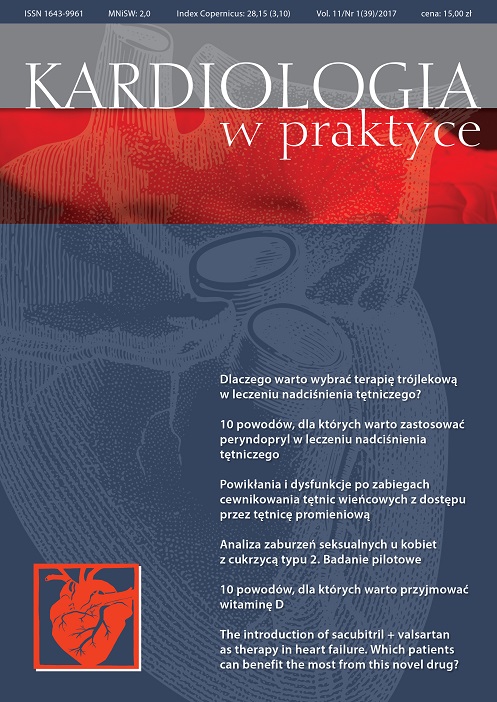Dlaczego warto wybrać terapię trójlekową w leczeniu nadciśnienia tętniczego? Artykuł przeglądowy
##plugins.themes.bootstrap3.article.main##
Abstrakt
W badaniach klinicznych wykazano, że u połowy chorych na nadciśnienie tętnicze jest ono nieprawidłowo kontrolowane, co wiąże się z nieprzestrzeganiem zaleceń lekarskich. Wielu pacjentów wymaga stosowania terapii trójlekowej, żeby osiągnąć zakładane cele leczenia, a obowiązujące wytyczne zalecają połączenia leków o komplementarnych mechanizmach działania. Dostępne jest połączenie trójlekowe o stałym składzie zawierające preparat hamujący układ renina–angiotensyna–aldosteron, antagonistę wapnia i diuretyk tiazydopodobny. Stałe połączenie trójlekowe odznacza się skutecznością, dobrą tolerancją, wygodą stosowania i pozwala osiągnąć prawidłową kontrolę ciśnienia tętniczego.
Pobrania
##plugins.themes.bootstrap3.article.details##

Utwór dostępny jest na licencji Creative Commons Uznanie autorstwa – Użycie niekomercyjne 4.0 Międzynarodowe.
Copyright: © Medical Education sp. z o.o. This is an Open Access article distributed under the terms of the Attribution-NonCommercial 4.0 International (CC BY-NC 4.0). License (https://creativecommons.org/licenses/by-nc/4.0/), allowing third parties to copy and redistribute the material in any medium or format and to remix, transform, and build upon the material, provided the original work is properly cited and states its license.
Address reprint requests to: Medical Education, Marcin Kuźma (marcin.kuzma@mededu.pl)
Bibliografia
2. Gupta A.K., Arshad S., Poulter N.R.: Compliance, safety, and effectiveness of fixed-dose combinations of antihypertensive agents: a meta-analysis. Hypertension 2010; 55: 399-407.
3. Bramley T.J., Gerbino P.P., Nightengale B.S. et al.: Relationship of blood pressure control to adherence with antihypertensive monotherapy in 13 managed care organizations. J. Manag. Care Pharm. 2006; 12: 239-245.
4. Fung V., Huang J., Brand R. et al.: Hypertension treatment in a Medicare population: adherence and systolic blood pressure control. Clin. Ther. 2007; 29: 972-984.
5. Wald D.S., Law M., Morris J.K. et al.: Combination therapy versus monotherapy in reducing blood pressure: meta-analysis on 11,000 participants from 42 trials. Am. J. Med. 2009; 122(3): 290-300.
6. Roas S., Bernhart F., Schwarz M. et al.: Antihypertensive combination therapy in primary care offices: results of a cross-sectional survey in Switzerland. Int. J. Gen. Med. 2014; 7: 549-556.
7. Weir M.R., Hsueh W.A., Nesbitt S.D. et al.: A titrate-to-goal study of switching patients uncontrolled on antihypertensive monotherapy to fixed-dose combinations of amlodipine and olmesartan medoxomil ± hydrochlorothiazide. J. Clin. Hypertens. (Greenwich) 2011; 13: 404-412.
8. Breitscheidel L., Ehlken B., Kostev K. et al.: Real-life treatment patterns, compliance, persistence, and medication costs in patients with hypertension in Germany. J. Med. Econ. 2012; 15: 155-165.
9. Toth K.: Antihypertensive efficacy of triple combination perindopril/indapamide plus amlodipine in high-risk hypertensives: results of the PIANIST study (Perindopril-Indapamide plus AmlodipiNe in high rISk hyperTensive patients). Am. J. Cardiovasc. Drugs. 2014; 14(2): 137-145.
10. Páll D., Szántó I., Szabó Z.: Triple combination therapy in hypertension: the antihypertensive efficacy of treatment with perindopril, amlodipine, and indapamide SR. Clin. Drug Investig. 2014; 34: 701-708.
11. Schafer H.H., Sudano I., Theus G.R. et al.: Target blood pressure attainment with antihypertensive therapy in Swiss primary care. Blood Press. 2012; 21: 211-219.
